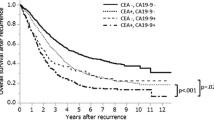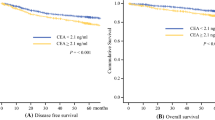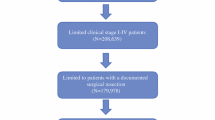Abstract
The relationship between the pattern of carcinoembryonic antigen (CEA) changes and the types of recurrence was investigated in a prospective study of 146 patients who underwent curative operations for adenocarcinoma of the colon or rectum. Recurrences developed in 51 patients (34.9%) and was local in 14, distant in 23, and both local and distant in 14 of them. CEA slope values were individually calculated beginning with an initial rise of more than 1 ng/ml, and expressed as the % rise in CEA per month. Patients who relapsed had significantly higher slopes than those who remained well (median 20.0% versus 0.3% rise,p<0.001). A slope value of 5% rise per month broadly separated the two groups with an overall accuracy of 79.4%, sensitivity rate for recurrence of 86.3%, and specificity rate for no relapse of 75.8%.
Median CEA slope values did not differ significantly among patients with different types of relapse. However, compared with patients who had any distant recurrence, more patients with localized recurrence had slope values of less than 5% rise per month (8.1% versus 28.6%, respectively; one-tailed p=0.04). Nevertheless, a slope exceeding a 5% rise per month was observed in 10 of the 14 patients with local recurrence.
We conclude that serial postoperative CEA monitoring is useful in detecting both local as well as distant recurrence. Furthermore, the use of slope analysis may enhance the sensitivity of postoperative CEA monitoring for detecting relapse.
Résumé
La relation entre les variations du taux de l'antigène carcino-embryonnaire et les divers types de récidive ont été étudiés chez 146 sujets qui avaient subi une opération à visée curative pour cancer du colon ou du rectum. La récidive s'est manifestée chez 51 opérés (34,9%), locale dans 24 cas, à distance dans 23 cas, locale et à distance dans 14 cas.
La pente des valeurs de l'antigène fut calculée pour chaque sujet dès que le taux de l'antigène atteignait 1 ng/ml et exprimée en pourcentage d'élévation de l'antigène pour chaque mois.
Les opérés qui récidivèrent présentèrent des pentes plus élevées que ceux qui furent exempts de récidive (médiane de 20,0% VS 0,3% d'élévation,p <0,001). Une élévation de la pente de 5% par mois séparaient les deux groupes avec un taux de précision de 79,4%, de sensibilité de 86,3%, de spécificité de 75,8%.
Les valeurs moyennes de la ligne de pente de l'antigène n'ont pas présenté une différence significative selon les divers types de récidive. Cependant par comparaison avec les opérés indemnes de récidive, la plupart des sujets atteints de récidive locale présentaient une ligne de pente inférieure à une élévation de 5% par mois (8,1% VS 28,6%, respectivement), encore que chez 10 opérés sur un groupe de 14, une ligne de pente supérieure à 5% par mois ait été observée.
On peut conclure de cette étude que le dosage régulier de l'antigène carcino-embryonnaire est utile pour dépister les récidives locales ou à distance. De plus, la constitution d'une ligne de pente renforce la sensibilité de la méthode de dépistage.
Resumen
La relación entre el patrón de alteración del antígeno carcinoembriónico (ACE) y los diferentes tipos de recurrencia fue investigada mediante un estudio prospectivo de 146 pacientes sometidos a operaciones curativas por adenocarcinoma de colon o del recto. Se presentaron recurrencias en 51 pacientes (34,9%), y éstas fueron de tipo local en 14, distal en 23 y local y distal en 14 de ellos. Los valores de inclinación de los niveles de ACE sérico en determinaciones postoperatorias seriadas fueron calculados individualmente para cada paciente, comenzando cuando se presentó una elevación de más de 1 ng/ml, y expresados como % de la elevación del ACE por mes. Los pacientes con relapso presentaron inclinaciones significativamente mayores que los pacientes que se mantuvieron libres de enfermedad (la media fue 20,0% vs elevación del 0,3%,p<0,001). Un valor de inclinación del 5% de aumento por mes separa en forma amplia los dos grupos, con una tasa global de seguridad de 79,4%, una tasa de sensibilidad para recurrencia de 86,3% y una tasa de especificidad de no relapso de 75,8%.
Las inclinaciones medias del nivel de ACE no difirieron significativamente en el grupo de pacientes con diferentes tipos de relapso. Sin embargo, al compararlos con los pacientes que exhibían alguna recurrencia distal, se encontró que más pacientes con recurrencia local tenían inclinaciones de menos del 5% de aumento por mes (8,1% vs 28,6%, respectivamente,p de un solo final = 0,04). No obstante, una inclinación en exceso de 5% de aumento por mes fue observada en 10 de los 14 pacientes con recurrencia local.
Hemos llegado a la conclusión de que la monitoría postoperatoria seriada del ACE es de utilidad en la detección de las recurrencias tanto locales como distales. Además, el uso del análisis de la inclinación puede acrecentar la sensibilidad de la monitoria postoperatoria del ACE como medio de detección del relapso.
Similar content being viewed by others
References
Summary of an NIH consensus statement. Carcinoembryonic antigen: its role as a marker in the management of cancer. Br. Med. J. 282:373, 1981
Wanebo, H.J., Rao, B., Pinsky, C.M., Hoffman, R.G., Stearns, M., Schwartz, M.K., Oettgen, H.F.: Preoperative carcinoembryonic antigen level as a prognostic indicator in colorectal cancer. N. Engl. J. Med.299:448, 1978
Wanebo, H.J., Stearns, M., Schwartz, M.K.: Use of CEA as an indicator of early recurrence and as a guide to a selected second-look procedure in patients with colorectal cancer. Ann. Surg.188:481, 1978
Lavin, P.T., Day, J., Holyoke, D.E., Mittelman, A., Chu, T.M.: A statistical evaluation of baseline and follow-up carcinoembryonic antigen in patients with resectable colorectal carcinoma. Cancer47:823, 1981
Szymendera, J.J., Nowacki, M.P., Szawlowski, A.W., Kaminska, J.A.: Predictive value of plasma CEA levels: Preoperative prognosis and postoperative monitoring of patients with colorectal carcinoma. Dis. Colon Rectum25:46, 1982
Goslin, R., Steele, G., Jr., Macintyre, J., Mayer, R., Sugarbaker, P., Cleghorn, K., Wilson, R., Zamcheck, N.: The use of preoperative plasma CEA levels for the stratification of patients after curative resection of colorectal cancers. Ann. Surg.192:741, 1980
Steele, G., Jr., Ellenberg, S., Ramming, K., O'Connell, M., Moertel, C., Lessner, H., Bruckner, H., Horton, J., Schein, P., Zamcheck, N., Novak, J., Holyoke, E.D.: CEA monitoring among patients in multi-institutional adjuvant G.I. therapy protocols. Ann. Surg.196:162, 1982
Wood, C.B., Ratcliffe, J.G., Burt, R.W., Malcolm, A.J.H., Blumgart, L.H.: The clinical significance of the pattern of elevated serum carcinoembryonic antigen (CEA) levels in recurrent colorectal cancer. Br. J. Surg.67:46, 1980
Carlsson, U., Stewenius, J., Ekelund, G., Leandoer, L., Nosslin, B.: Is CEA analysis of value in screening for recurrences after surgery for colorectal carcinoma? Dis. Colon Rectum26:369, 1983
American Joint Committee for Cancer Staging and End Results Reporting. Manual for Staging of Cancer. Chicago, 1977
Staab, H.J., Anderer, F.A., Stumpf, E., Fischer, R.: Slope analysis of the postoperative CEA time course and its possible application as an aid in diagnosis of disease progression in gastrointestinal cancer. Am. J. Surg.136:322, 1978
Siegel, S.: Nonparametric Statistics for the Behavioral Sciences. New York, McGraw-Hill Book Co., 1956
Cox, D.R.: Regression models and life tables. J.R. Statist Sol.(B)34:187, 1972
Rittgers, R.A., Steele, G., Zamcheck, N., Loewenstein, M.S., Sugarbaker, P.H., Mayer, R.J., Lokich, J.J., Maltz, J., Wilson, R.E.: Transient carcinoembryonic antigen (CEA) elevations following resection of colorectal cancer: A limitation in the use of serial CEA levels as an indicator for second-look surgery. J. Natl. Cancer Inst.61:315, 1978
Beart, R.W., Jr., Metzger, P.P., O'Connell, M.J., Schutt, A.J.: Postoperative screening of patients with carcinoma of the colon. Dis. Colon Rectum24:585, 1981
Wedell, J., Eissen, M.Z., Luu, T.H., Fiedler, R., Calker, H.V., Koldowski, P., Schlipkoter, H.W.: A retrospective study of serial CEA. Determinations in the early detection of recurrent colorectal cancer. Dis. Colon Rectum24:618, 1981
Finley, I.G., McArdle, C.S.: Role of carcinoembryonic antigen in detection of asymptomatic disseminated disease in colorectal carcinoma. Br. Med. J.286:1242, 1983
Goldenberg, D.M., Kim, E.E., Bennett, S.J., Nelson, M.O., Deland, F.H.: Carcinoembryonic antigen: Radioimmuno-detection in the evaluation of colorectal cancer and in the detection of occult neoplasms. Gastroenterology84:524, 1983
Berche, C., Mach, J.P., Lumbroso, J.D., Langlais, C., Aubry, F., Buchegger, F., Carrel, S., Rougier, P., Parmentier, C., Tubiana, M.: Tomoscintigraphy for detecting gastrointestinal and medullary thyroid cancers: First clinical results using radiolabeled monoclonal antibodies against carcinoembryonic antigen. Br. Med. J.285:1447, 1982
Tornqvist, A., Ekelund, G., Leandoer, L.: The value of intensive follow-up after curative resection for colorectal carcinoma. Br. J. Surg.69:725, 1982
Martin, E.W., Jr., Cooperman, M., Carey, L.C., Minton, J.P.: Sixty second-look procedures indicated primarily by rise in serial carcinoembryonic antigen. J. Surg. Res.28:389, 1980
Attiyeh, F.F., Stearns, M.W., Jr.: Second-look laparotomy based on CEA elevations in colorectal cancer. Cancer47:2119, 1981
Author information
Authors and Affiliations
Additional information
Supported by grants from the University Research and Grants Committee, University of Hong Kong.
Rights and permissions
About this article
Cite this article
Boey, J., Cheung, H.C., Lai, C.K. et al. A prospective evaluation of serum carcinoembryonic antigen (CEA) levels in the management of colorectal carcinoma. World J. Surg. 8, 279–286 (1984). https://doi.org/10.1007/BF01655052
Issue Date:
DOI: https://doi.org/10.1007/BF01655052




